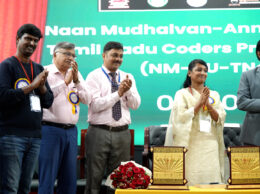JODHPUR : Realizing the significance of cooling power sources in Nuclear Power Plants safety based on the historical nuclear disasters, Indian Institute of Technology Jodhpur researchers proposed offshore wind farms as seismically resilient alternate power sources to cater the coolant requirements of Nuclear Power Plants. An existing nuclear power plant in India, Madras Atomic Power Station, Chennai is chosen as the case study for demonstrating the applicability of the proposed strategy. The proposed methodology involves a series of stages. It commences with the estimation of coolant power needs in nuclear reactors, followed by the design of an offshore wind turbine and its corresponding infrastructure. Finally, a seismic safety evaluation was conducted on the selected offshore wind turbine site, considering different scenario levels.
Dr. Pradeep Kumar Dammala, Assistant Professor, Department of Civil and Infrastructure Engineering, IIT Jodhpur and Ms. Sumaja Kolli, MTech-PhD Scholar, Department of Civil and Infrastructure Engineering, IIT Jodhpur along with the researchers from University of Surrey, United Kingdom, Tsinghua University, China, and Institute of Engineering Mechanics, China, have published this article in Nuclear Engineering and Design Journal
(DOI: https://doi.org/10.1016/j.nucengdes.2023.112204).
The study proposed a novel approach to enhance the robustness of cooling power in Nuclear Power Plants during seismic events. By utilizing sustainable wind power, the study demonstrates the feasibility of strengthening the reliability of cooling power in Nuclear Power Plants. Through a case study conducted at the Madras Atomic Power Station in Chennai, India, the proposed offshore wind farm is shown to be resilient to seismic events at the site and capable of meeting Madras Atomic Power Station coolant requirements. This research contributes to advancing the integration of sustainable and resilient energy sources in earthquake-prone regions to enhance the reliability of Nuclear Power Plants.
Major conclusions of this case study are:
- The proposed 15 MW offshore wind farm with three NREL 5 MW turbines supported by monopile foundations at the Kalpakkam area could potentially act as the additional emergency backup power source for meeting the cooling power requirements of existing nuclear power plants.
- The offshore wind turbines monopile foundation was analyzed under anticipated dynamic loading conditions considering the soil nonlinearity and seismic liquefaction employing the state-of-the-art numerical models.
- The nonlinear integrated seismic analyses conducted on the proposed offshore wind turbines depicted acceptable seismic performance on comparing the monopile mudline displacements and bending moments.
The concept was initially originated in 2011 when Prof. Bhattacharya, the third author, witnessed the impact of the Tohoku earthquake in Japan. The idea was published in Soil Dynamics and Earthquake Engineering journal and pursued further by Dr. Dammala during his research at the University of Surrey, UK. Dr. Dammala conducted additional case studies on seismic resilience, including a road-cum-railway bridge in Guwahati and a public building, resulting in publications in renowned journals and conferences (Dammala et al. 2017 and Dammala and Krishna 2019).
Talking about the future scope of the research, Dr. Pradeep Kumar Dammala, Assistant Professor, Department of Civil and Infrastructure Engineering, IIT Jodhpur, said, “Given India’s pursuit of nuclear energy development and the inevitable presence of seismic and tsunamic threats in close proximity, it becomes imperative to enhance the safety of nuclear structures to the highest degree possible.”
He further added, “This suggested approach serves as an excellent framework for evaluating the seismic resilience of nuclear power plants and the integration of wind energy sources during interconnected events like earthquakes and tsunamis.”
It is notable that Dr. Dammala also conducted an Indo-UK International Workshop on Design of Foundation Systems for Offshore Wind Turbines – Indian Perspective, earlier this year on 4th February 2023, which was attended by more than 200 participants from 14 different countries.
This current research was funded by UK India Education Research Initiative (UKIERI) and Commonwealth Scholarship Commission, United Kingdom to Dr. Pradeep Kumar Dammala. India’s Three-stage nuclear program focuses on the advancement of Thorium-based reactors. The second stage involves the development of a Plutonium-fueled Fast Breeder Reactor (FBR). Among India’s seven Nuclear Power Plants, five are located in seismically active zones III and IV, with three in coastal areas prone to hazards like tsunamis and cyclones. The Madras Atomic Power Station in Kalpakkam, housing two 220 MW FBRs, serves as an example. To ensure the robustness and resilience of these advanced nuclear reactors, this study proposes leveraging sustainable wind energy to enhance cooling power requirements.









